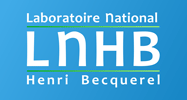Cryogenic detectors

In various fields of ionizing radiation metrology, cryogenic detectors can provide better performance than conventional detectors, and in some cases a redundant measurement method based on a totally different detection principle.
For several years, the LNHB has chosen to focus on the development of metallic magnetic calorimeters (MMCs), the type of cryogenic detector best suited for its applications. The radiation absorber is made up of a noble metal (gold, silver or a combination of the two) with a high atomic number and a high density that allows for good detection efficiencies. The absorber is thermally coupled to a paramagnetic thermometer, consisting in a thin film of a paramagnetic gold-erbium or silver-erbium alloy and subjected to a magnetic field. The temperature increase resulting from the interaction of a particle in the absorber, is translated by the thermometer to a variation of its the magnetization. This is converted into an electrical signal via a superconducting quantum interference device (SQUID) magnetometer and amplified.
The current project covers several applications for this type of detector: nuclear and atomic data measurement, actinide quantification, and alpha and beta spectrometry.
In particular, the following objectives are targeted:
- Development of a technique to quantify actinides by X-ray and γ spectrometry. This technique will be based on the X-ray and γ emission probabilities of actinides determined with one of the MMCs developed in the laboratory,
- Development of a simple technique for the quantification of actinides by Q spectrometry (measurement of total decay energy),
- Measurement of the shapes of beta spectra with MMCs offering a very low energy threshold, a detection efficiency of 100% between the energy threshold and the maximum energy of the spectrum, and an energy resolution of a few per-mille of the maximum energy. This study complements the theoretical study of beta spectra conducted at LNHB,
- Measurement of alpha spectra with an energy resolution of less than 3 keV and applications: measurement of alpha emission probabilities, separation of closely spaced lines in mixtures of alpha emitters, detection of alpha emitting impurities in alpha sources.
- Measurement of electron capture probabilities and X-ray emission probabilities for nuclides disintegrating by electron capture.
COLLABORATIVE PROJECT:
– MetroBETA (Metrology-based improvements to radionuclide beta spectra), Website: metrobeta.empir.eu
– ANR Project: LUMINEU, Website: lumineu.in2p3.fr
COLLABORATIONS:
Heidelberg University (Germany), CEA (Direction de la Recherche Fondamentale)
REFERENCES:
M. Loidl, M. Rodrigues, C. Le-Bret and X. Mougeot, “Beta spectrometry with metallic magnetic calorimeters”, (2014), Applied Radiation and Isotopes, 87, Pages 302-305
Doi: https://dx.doi.org/10.1016/j.apradiso.2013.11.024
D. Gray, C. Enss, A. Fleischmann, L. Gastaldo, C. Hassel, D. Hengstler, S. Kempf, M. Loidl, X. F. Navick and M. Rodrigues, The first tests of a large area light detector equipped with metallic magnetic calorimeters for scintillating bolometers for the LUMINEU neutrinoless double beta decay search, (2016) J. Low Temp. Phys. (2016), Vol 184, Issue3, pp 904-909
Doi: https://doi.org/10.1007/s10909-016-1535-7
